应用文体翻译
- 格式:docx
- 大小:46.50 KB
- 文档页数:2
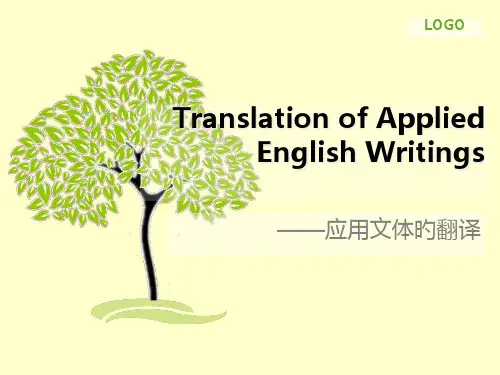


应用文体地道翻译资料存包处使用说明存1、 请按“存”键。
2、 取密码纸,自动开箱。
3、 存入物品,关好箱门。
取1、 密码纸靠近读码口自动开箱2、 取物后,请关好箱门。
Free Locker Deposit 1. Please press the key deposit. 2. Take the password paper. Door ope ned automatically. 3. Deposit your articles and close the door Withdrawal 1. The password paper is tight near the sca n. Door ope ned automatically 2. Please close the door afterwithdrawal no tice.Public Lock (参考的平行文本) To use 1. Open the door 2. Place articles in side 3. In sert quarter ( It will be retur ned) 4. Turn and remove key To remove contents 1. In sert key and tur n 2. Open the door 3. Quarter retur ns in slotPublic Lock To use 1. Press the deposit ”key 2. Take the barcode and the door ope ns 3. Place articles in side and close the door To remove contents 1. Press the barcode aga inst the sca nne and the door ope ns. 2. Remove the things and close the doo”例2旅客须知1. 旅客登记时,须凭足以证明本人身份的有效证件,并说明住宿原因。
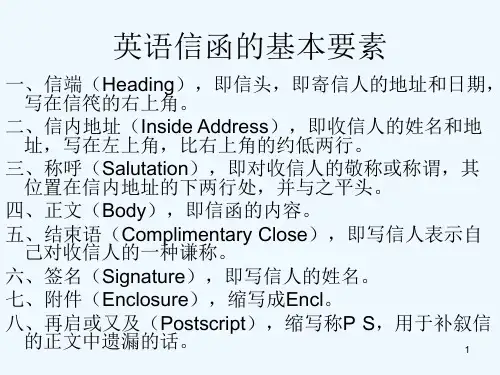
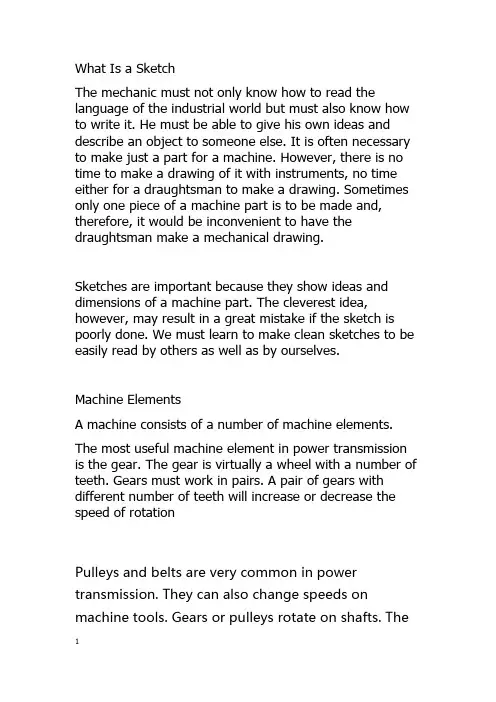
What Is a SketchThe mechanic must not only know how to read the language of the industrial world but must also know how to write it. He must be able to give his own ideas and describe an object to someone else. It is often necessary to make just a part for a machine. However, there is no time to make a drawing of it with instruments, no time either for a draughtsman to make a drawing. Sometimes only one piece of a machine part is to be made and, therefore, it would be inconvenient to have the draughtsman make a mechanical drawing.Sketches are important because they show ideas and dimensions of a machine part. The cleverest idea, however, may result in a great mistake if the sketch is poorly done. We must learn to make clean sketches to be easily read by others as well as by ourselves.Machine ElementsA machine consists of a number of machine elements. The most useful machine element in power transmission is the gear. The gear is virtually a wheel with a number of teeth. Gears must work in pairs. A pair of gears with different number of teeth will increase or decrease the speed of rotationPulleys and belts are very common in power transmission. They can also change speeds on machine tools. Gears or pulleys rotate on shafts. Theshaft must rest in bearings. Sometimes there may be couplings between shafts. We may use clutches to start or stop shaft motion.Some machine elements may be very large. Others may be very small. However, each of them plays a part in the construction of a machine.Cutting ToolsThe metal cutting tool separates chips from the workpiece in order to cut the part to the desired shape and size. There is a great variety of metal cutting tools. Each of them is designed to perform a particular job or a group of metal cutting operations in an efficient manner. For example, a twist drill is designed to drill a hole which has a particular size, while a turning tool may be used to turn a variety of cylindrical shapes.There are three basic types of metal cutting tools: single-point tools, multiple-point tools, and abrasives. A single-point metal cutting tool has a single cutting edge and is used for turning, boring, shaping, and planning. The most common machine tool that employs the single-point cutting tool is the engine lathe. Multiple-point tools have two or more cutting edges such as drills, reamers, and milling cutters. The cutting edge is that part of the tool where cutting is actually done. Grinding wheels are an example of abrasive cutting tools. Each grinding wheel hasa lot of abrasive grains which act as very small cutting tools.Limits and TolerancesMachine parts are manufactured so they areinterchangeable. In other words, each part of a machineor mechanism is made to a certain size and shape so itwill fit into any other machine or mechanism of the same type. To make the part interchangeable, each individual part must be made to a size that will fit the mating part inthe correct way. It is not only impossible, but alsoimpractical to make many parts to an exact size. This isbecause machines are not perfect, and the tools becomeworn. A slight variation from the exact size is alwaysallowed. The amount of this variation depends on the kindof part being manufactured. For example, a part might bemade 6 inches long with a variation allowed of 0.003( three thousandths ) inches above and below this size.Therefore the part could be 5.997 to 6.003 inches and stillbe the correct size. These are known as the limits. Thedifference between upper and lower limits is called the tolerance.When the tolerance is in both directions from the basic size, it is known as a bilateral tolerance ( plus and minus ). Sometimes the limit is allowed in only one direction. This is known as unilateral tolerance. For example, a hole may have to be 2 inches minus 0.000 inches, or plus 0.005 inches. This means that the hole must not be smaller than 2 inches, but can be as large as 2.005 inches.Surface FinishWithin recent years a great deal of attention has been given to the invesigation of the surface texture produced by various machining and finish operations, and, although we have not yet reached the stage when surface finish requirements can be specified and produced just as it is possible for a given dimension, information is being built up which may in the end bring this about.If a machine surface is reproduced to a large enough magnification it will be found to have a wevy profile, the character and shape of the waves varying for different machining methods. Equipment is now available which will produce an enlarged contour of a surface by traversing a needle-like probe over it, the instrument at the same time plotting on a chart a greatly magnified reproduction of the up-and-down movement of the probe with its longitudinal traverse.。

语义翻译和交际翻译在翻译中的应用沈涵文河南大学,河南开封475000一、文本类型理论彼得·纽马克是一位现代语言学教授,任教于英国萨里大学,主要从事翻译理论和翻译实践的教学。
纽马克在布勒语言功能的基础上,根据不同的内容和文体,将文本类型分为表达型文本、信息型文本和呼唤型文本。
表达型文本重视原文作者的权威,关注原作者思想感情,不会考虑读者的反应。
以下几种属于典型的表达型文本:抒情诗、小说、戏剧等严肃性作品;国家政治人物的演讲稿或文件、各种法规和法律文献等权威性言论;自传、散文和私人信件等抒发个人感情的作品。
这些纯属是作者个人感情的宣泄,读者背景模糊,不关注读者的反应。
信息型文本注重对客观事物进行描述,它的语言常常比较客观,不带个人特色,重在信息的传递,而语言正是传递信息的工具。
其用词、搭配等通常较为传统。
典型的信息型文本可以涵盖以下几个方面:经济、科学、技术、商业、工业等,常常以教材、报告、报纸、论文、备忘录和会议记录等形式呈现。
号召型文本强调以读者为中心,关注读者的反应。
目的是号召读者按照作者意图来思考、感受并有所行动。
典型的号召型文本包括:告示、说明书、宣传手册、广告等。
一个文本常常会具备几种功能,但往往以其中一种功能为主[1]。
同一文本会因为不同的交际时间、地点、背景和对象产生不同的功能[2]。
二、语义翻译和交际翻译理论含义20世纪末期,彼得·纽马克出版了《翻译问题探讨》(Approaches to Translation),在这本书中,他首次引入了语义翻译和交际翻译这两个概念。
语义翻译以原文作者为出发点,竭力将原文的信息贴切地传达出来。
其更偏重于对原文文本的呈现,也就是在不违反语法规则的情况下将原文内容尽可能地再现。
因此,在进行语义翻译时,译文应该在译语的语义和句法结构允许的情况下尽可能准确地再现原文的上下文意义,使得译文与原文在文体风格上尽可能地相似,从而使读者有更精准的阅读体验。
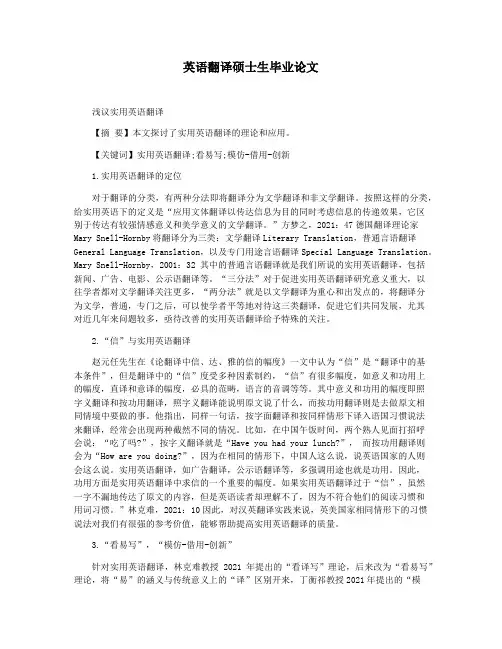
英语翻译硕士生毕业论文浅议实用英语翻译【摘要】本文探讨了实用英语翻译的理论和应用。
【关键词】实用英语翻译;看易写;模仿-借用-创新1.实用英语翻译的定位对于翻译的分类,有两种分法即将翻译分为文学翻译和非文学翻译。
按照这样的分类,给实用英语下的定义是“应用文体翻译以传达信息为目的同时考虑信息的传递效果,它区别于传达有较强情感意义和美学意义的文学翻译。
”方梦之,2021:47德国翻译理论家Mary Snell-Hornby将翻译分为三类:文学翻译Literary Translation,普通言语翻译General Language Translation,以及专门用途言语翻译Special Language Translation。
Mary Snell-Hornby,2001:32 其中的普通言语翻译就是我们所说的实用英语翻译,包括新闻、广告、电影、公示语翻译等。
“三分法”对于促进实用英语翻译研究意义重大,以往学者都对文学翻译关注更多,“两分法”就是以文学翻译为重心和出发点的,将翻译分为文学,普通,专门之后,可以使学者平等地对待这三类翻译,促进它们共同发展,尤其对近几年来问题较多,亟待改善的实用英语翻译给予特殊的关注。
2.“信”与实用英语翻译赵元任先生在《论翻译中信、达、雅的信的幅度》一文中认为“信”是“翻译中的基本条件”,但是翻译中的“信”度受多种因素制约,“信”有很多幅度,如意义和功用上的幅度,直译和意译的幅度,必具的范畴,语言的音调等等。
其中意义和功用的幅度即照字义翻译和按功用翻译,照字义翻译能说明原文说了什么,而按功用翻译则是去做原文相同情境中要做的事。
他指出,同样一句话,按字面翻译和按同样情形下译入语国习惯说法来翻译,经常会出现两种截然不同的情况。
比如,在中国午饭时间,两个熟人见面打招呼会说:“吃了吗?”,按字义翻译就是“Have you had your lunch?”,而按功用翻译则会为“How are you doing?”,因为在相同的情形下,中国人这么说,说英语国家的人则会这么说。
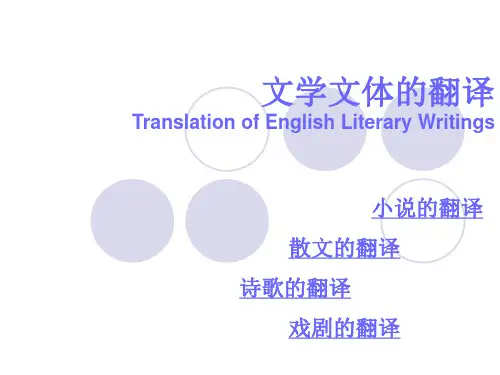

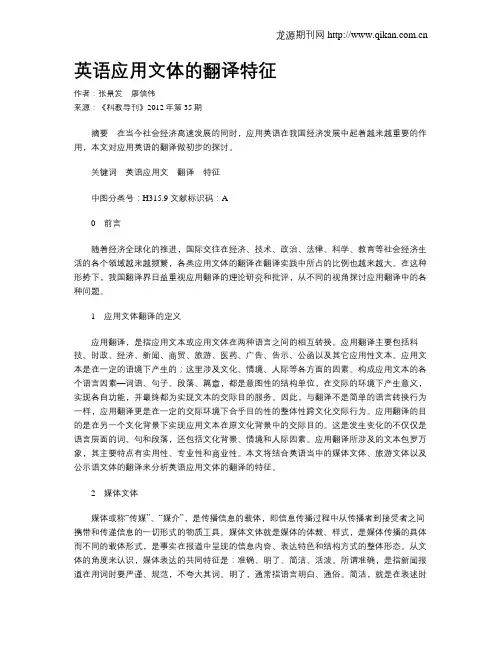
英语应用文体的翻译特征作者:张景发廖信伟来源:《科教导刊》2012年第35期摘要在当今社会经济高速发展的同时,应用英语在我国经济发展中起着越来越重要的作用,本文对应用英语的翻译做初步的探讨。
关键词英语应用文翻译特征中图分类号:H315.9 文献标识码:A0前言随着经济全球化的推进,国际交往在经济、技术、政治、法律、科学、教育等社会经济生活的各个领域越来越频繁,各类应用文体的翻译在翻译实践中所占的比例也越来越大。
在这种形势下,我国翻译界日益重视应用翻译的理论研究和批评,从不同的视角探讨应用翻译中的各种问题。
1应用文体翻译的定义应用翻译,是指应用文本或应用文体在两种语言之间的相互转换。
应用翻译主要包括科技、时政、经济、新闻、商贸、旅游、医药、广告、告示、公函以及其它应用性文本。
应用文本是在一定的语境下产生的;这里涉及文化、情境、人际等各方面的因素。
构成应用文本的各个语言因素—词语、句子、段落、篇章,都是意图性的结构单位,在交际的环境下产生意义,实现各自功能,并最终都为实现文本的交际目的服务。
因此,与翻译不是简单的语言转换行为一样,应用翻译更是在一定的交际环境下合乎目的性的整体性跨文化交际行为。
应用翻译的目的是在另一个文化背景下实现应用文本在原文化背景中的交际目的。
这是发生变化的不仅仅是语言层面的词、句和段落,还包括文化背景、情境和人际因素。
应用翻译所涉及的文本包罗万象,其主要特点有实用性、专业性和商业性。
本文将结合英语当中的媒体文体、旅游文体以及公示语文体的翻译来分析英语应用文体的翻译的特征。
2媒体文体媒体或称“传媒”、“媒介”,是传播信息的载体,即信息传播过程中从传播者到接受者之间携带和传递信息的一切形式的物质工具。
媒体文体就是媒体的体裁、样式,是媒体传播的具体而不同的载体形式,是事实在报道中呈现的信息内容、表达特色和结构方式的整体形态。
从文体的角度来认识,媒体表达的共同特征是:准确、明了、简洁、活泼。
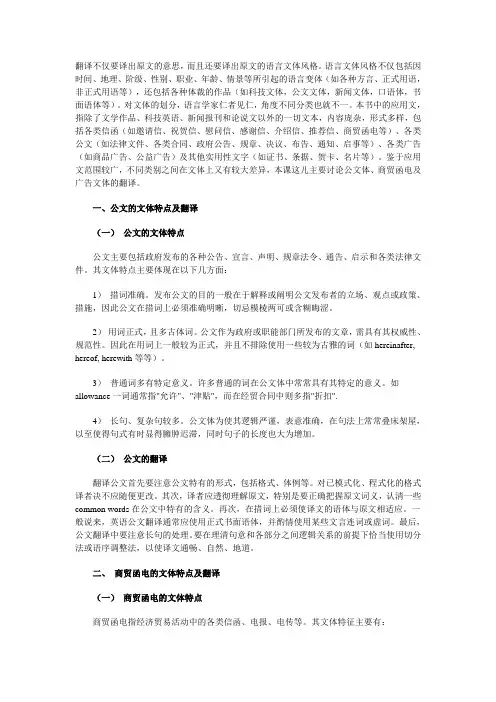
翻译不仅要译出原文的意思,而且还要译出原文的语言文体风格。
语言文体风格不仅包括因时间、地理、阶级、性别、职业、年龄、情景等所引起的语言变体(如各种方言、正式用语,非正式用语等),还包括各种体裁的作品(如科技文体,公文文体,新闻文体,口语体,书面语体等)。
对文体的划分,语言学家仁者见仁,角度不同分类也就不一。
本书中的应用文,指除了文学作品、科技英语、新闻报刊和论说文以外的一切文本,内容庞杂,形式多样,包括各类信函(如邀请信、祝贺信、慰问信、感谢信、介绍信、推荐信、商贸函电等)、各类公文(如法律文件、各类合同、政府公告、规章、决议、布告、通知、启事等)、各类广告(如商品广告、公益广告)及其他实用性文字(如证书、条据、贺卡、名片等)。
鉴于应用文范围较广,不同类别之间在文体上又有较大差异,本课这儿主要讨论公文体、商贸函电及广告文体的翻译。
一、公文的文体特点及翻译(一)公文的文体特点公文主要包括政府发布的各种公告、宣言、声明、规章法令、通告、启示和各类法律文件。
其文体特点主要体现在以下几方面:1)措词准确。
发布公文的目的一般在于解释或阐明公文发布者的立场、观点或政策、措施,因此公文在措词上必须准确明晰,切忌模棱两可或含糊晦涩。
2)用词正式,且多古体词。
公文作为政府或职能部门所发布的文章,需具有其权威性、规范性。
因此在用词上一般较为正式,并且不排除使用一些较为古雅的词(如hereinafter, hereof, herewith等等)。
3)普通词多有特定意义。
许多普通的词在公文体中常常具有其特定的意义。
如allowance一词通常指"允许"、"津贴",而在经贸合同中则多指"折扣".4)长句、复杂句较多。
公文体为使其逻辑严谨,表意准确,在句法上常常叠床架屋,以至使得句式有时显得臃肿迟滞,同时句子的长度也大为增加。
(二)公文的翻译翻译公文首先要注意公文特有的形式,包括格式、体例等。
一.英译中部分:What Is All This Talk About Blue TeethBluetooth is the newest kid on the technology block, and it holds a lot of promise for the assistive technology industry. Named for a 10th Century King of Denmark who unified the kingdoms of Denmark and Norway, Bluetooth is a shot-range wireless communication specification that promises to improve and increase electronic access to a number of environments by overcoming some of the obstacles typical of current technology. Bluetooth technology will enable devices to communicate and transfer data wirelessly and without the line-of-site issues of infra red technology.So how does it work?Bluetooth devices search each other out within their given operational range. Unlike devices that are wired together, Bluetooth devices do not have to be aware of the capabilities or properties of the devices to which they will connect beforehand. Bluetooth devices have a built-in mechanism that lets each device identify itself as well as its capabilities as it connects into this new Bluetooth network. This dynamic network does have a controlling device that designates itself as the matter for the connection. Its programming and the capabilities necessary for the given task determine whether or not a device can be a master. For example, a cell phone may act as a master device when connecting to a headset, an ATM, or an information kiosk. However, the same cell phone or headset may act as a slave device to the information kiosk, now acting as the master device, broadcasting emergency evacuation information. The cell phone and kiosk can function in either capacity depending on the required function and their programming.参考译文:一.“蓝牙”技术漫谈“蓝牙”作为技术家族的新生儿,为辅助性技术作业带来了不少希望。
刘宓庆《⽂体与翻译》(第2版)配套题库(第7~8章)【圣才出品】刘宓庆《⽂体与翻译》(第2版)配套题库第七章应⽤⽂体7.1应⽤⽂体的特点及汉译要点Ⅰ.试将下列⼴告语译成汉语。
1.Not all cars created equal.(⽇本三菱汽车⼴告)【译⽂】独⼀⽆⼆,三菱汽车。
2.You know who you are.(法国Peugeot汽车⼴告)【译⽂】标致,只有⾃⼰知道。
3.Now you can have your cake and diet too.(蛋糕⼴告)【译⽂】有了减肥蛋糕,还犹豫什么,开动吧!4.A deal with us means a good deal to you.(百货公司⼴告)【译⽂】与我们交易,您受益良多。
5.Give a SEIKO to all,and to all a good time.(⽇本精⼯⼿表⼴告)【译⽂】精致时间,精⼯打造。
6.Would you be more careful if it was you that got pregnant?【译⽂】换做是你怀孕了,你会更为谨慎吗?7.If you are what you eat,a visit to North Carolina could make you a veryinteresting person,indeed.【译⽂】⾷物造就⼈的品质,北卡罗来纳成就您的康乐。
8.The driver is safer when the road is dry;the road is safer when the driver is dry.(交通⼴告)【译⽂】道路不沾⽔,司机更安全;司机不沾酒,道路更安全。
9.No Excuses,Guaranteed,Best for Quality,Always Available,Right Price,At YourService.(ASDA超市⼴告)【译⽂】顾客⾄上,放⼼产品,质量最佳,⽅便实⽤,价格合理,竭诚服务。
关于“请小心衣服弄脏你的口红”的翻译
2090214132王俊
1.图片说明
●图片来源:李宁专卖店更衣室
●图片:
●文字功能:我们可以看到此图片中的中文标语是“请小心衣服弄花您的口红”,对应英
文翻译是”Please the careful clothes mishandle flowers you the lipstick !”.
此条标语是李宁专卖店内用来提醒顾客试衣服的时候不要把口红沾到衣服上,以免将其弄脏。
这条标语属于提示性公共语。
2.分析
●分析该图片标语: 从整个译本来看,这条标语完全是按照字面直译过来,首先语法是完
全错误。
请小心衣服弄脏您的口红,这句话是一个祈使句,并且用于提示作用,译文中careful 是形容词,前应跟be动词,在此句中前是定冠词the ,若是按照此版本来译,首先缺乏系动词。
在选择单词上也有不适,例如“mishandle”的本意是“粗暴的对待,虐待,胡乱的处置”,,显然这里对应的是弄,花的对应翻译就是flower,而根据原中文版本,句中弄花一起应是作为谓语动词的,表示把整洁好的东西弄脏,而对应的翻译mishandle flower 不仅词性不对,意义更是让人一头雾水。
●分析同等或类似功能的英语:还看到另外一个翻译版本是“Carefully try to avoid
lipstick touch on clothes” .先从后半分看起,此标语是为了提醒试衣服的顾客不要把口红印到衣服上,而对应的英文翻译是“avoid lipstick touch on clothes ”,很显然,在基本意思,信息对等上是符合的。
但是在此翻译中的“touch”一词使用是很有问题的,不难看出“touch”应是用来对应“印”的翻译,且在此句中是作为名词使用的,可“touch”作为名词是有触摸之意,是不能作为合适的对等翻译。
3.建议
●这条标语的目的,属于公众性提示语,表面上看是说不要让口红弄脏你的衣服,其言
下之意是怕你的口红弄脏了人家的衣服,但是这话反过来一说,反倒让试衣服的人不好意思。
文明穿衣,试穿文明。
这样,商家和消费者都会很愉快。
在应用文体翻译中,根据skopostheorie , 功能指的是从接收者角度所理解的文本含义或文本意欲传递的含义。
翻译目的论的定义是在目的与背景下,以目的语为目的,为目的语环境和读者,生产一个文本所以在翻译时应该直接按照其所表达的意义直接译。
上面这条标语是根据中国人的思维习惯,以及语境习惯所写的,而外国人思考事物的方式通常比较直接。
很显然像此译本中的翻译是极不合理的,没有明确传达标语本身目的。
综合以上对此译本的语法分析以及目的和理性分析,自然就更谈不上其优美之处。
因此对于本句的翻译建议修改为”No lipstick stain on the clothes !”.究其此标语的本质是为警示作用,译为以“no “开头的句子首先从语气上就达到了效果,句中的“stain “一词的选择也是很合适的,其本意是表示污点污迹,而此句的意图正是想表明口红若印到到衣服就将其弄脏,所以用词的恰当也让其信息的传达更简单明准确。